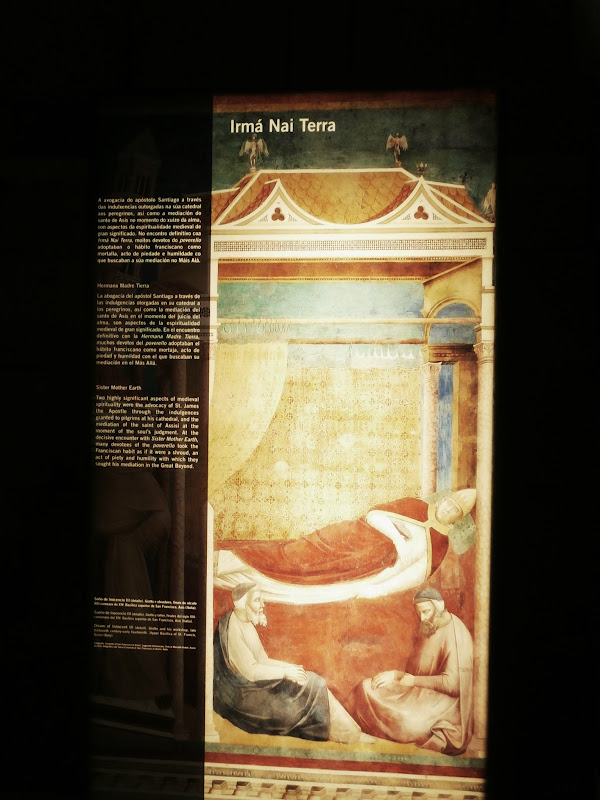2015/07/16
Palacio de Gelmírez and Exhibition St. Francis and His Time. Santiago de Compostela. Part 2.
After seeing the room in the lobby with the first two panels of the exhibition, we go outside the building. From here (42.880761, -8.545039) you can see part of the north facade of the Basilica of the Cathedral, in which we see two coats of arms and some corbels.
Detail of the north façade of the Cathedral, we see one of the two coats of arms and the corbels.
42.880761, -8.545039
Detail of the first of the two coats of arms, dated 1663. The ten tassels we can see on each side tell us that is the shield of an archbishop (https://en.wikipedia.org/wiki/Ecclesiastical_heraldry).
The corbels are from the Romanesque period.
This is the second of the two coats of arms. It is like the other but seems to be dated in the year 1008.
Now we re-enter the building. The entrance is on the left.
The wall of the Palacio with its buttresses.
We are in the part of the ground floor of the Palacio de Gelmírez which was dedicated to warehouse. There is only one room: Room Irmá Nai Terra.
Access to the room. We can see to the left the stairs leading to the upper floor.
The panel in this room. Transcription:
Sister Mother Earth.
Two highly significant aspects of medieval spirituality were the advocacy of St. James the Apostle through the indulgences granted to pilgrims at his cathedral, and the mediation of the saint of Assisi at the moment of the soul´s judgment. At the decisive encounter with Sister Mother Earth, many devotees of the poverello took the Franciscan habit as if it were a shroud, an act of piety and humility with which they sought his mediation in the Great Beyond.
Dream of Innocent III (detail). Giotto and his workshop, late thirteenth century – early fourteenth. Upper Basilica of St. Francis, Assisi (Italy).
Detail of the panel.
The two pieces exhibited in this room.
The tombstone of notary Pedro Aras. Anonymous of Compostela. ca 1400. Granite. Museo Catedralicio de Santiago de Compostela.
The tombstone of a Franciscan. From the Convento de San Francisco of A Coruña. Anonymous. 14th-15th centuries. Granite. Museo Arqueológico e Histórico del Castillo de San Antón. A Coruña.
Stairs leading to the next floor.
This small window is situated in the corridor that leads to the stairs.
We climb the stairs.
While climbing the stairs we see again the northern façade of the Basilica of the Cathedral the corbels of the Romanesque period and one of the two coats of arms that we have seen before. Also we can see these Romanesque windows.
Romanesque corbels and window.
We are now on the first floor. We see the entrance to the old kitchen of the Palacio de Gelmírez, Romanesque of the twelfth century with barrel vault. Access to the next floor is on the left.
This is a window called ventana geminada or aljimez. It has a mullion (vertical strip between panes of window). The window is situated between the kitchen and the corridor that leads to the stairs to the next floor.
Lintel and mochetas (mocheta is an architectural element that supports the lintel). They are located over the access door to the stairs leading to the second floor, next to the ventana geminada.
Before entering the room of the exhibition located in the old kitchen we look to our right and see the corridor that leads to the two other rooms on this floor that we will visit later.
Room located in the old kitchen of the Palacio, Romanesque of the twelfth century as we have mentioned.
Panel in this room, Unha Parada no Camiño. Transcription:
Stopping along the Camino.
Pilgrims would stop at monasteries and hospitals along the way to rest and take in nourishment: bread, wine and a cooked dish of some sort. Travelling friars and those making a pilgrimage were authorized to eat any food they were offered, reserving periods of abstinence for their cloistered life.
Charriot of fire (detail). Giotto and his workshop, late thirteenth century – early fourteenth. Upper Basilica of St. Francis, Assisi (Italy).
Explanatory text about the pieces exhibited, the text is the same in the two display cases: Grey ceramic tableware. Workshop of León. Thirteenth century. Museo de León.
We can see the outside, the northern façade of the Cathedral is seen again now from the interior of the former kitchen.
Now we return to the corridor, we see to the left the access door to the next room. (We will see it in Part 3).
End of Part 2.
Part 1
Part 3
Part 4
Part 5
Part 6
Subscribe to:
Post Comments (Atom)

































No comments:
Post a Comment